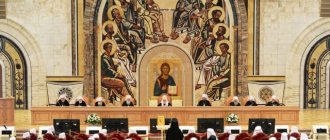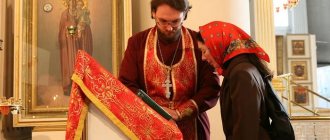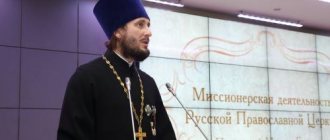What is church singing?
What is singing? This is the vocal used for worship. The oldest type is recognized as a psalm. This is a song of praise found in the Book of Psalms. The chant can be performed by one person or by a whole choir.
Previously, there were whole battles of choirs and concerts. Later this developed into difficult creativity. Today it is held in theological seminaries.
***
In church singing there should be: seriousness, calmness, evenness, clarity, prayerfulness and the so-called purity or purity of singing. The opposite of all this: shouting (unruly screaming), abruptness, too high rises and falls, inarticulateness and sentimentality, sensuality of singing. We pointed out the integrity and purity of singing. This aspect, unfortunately, is too disrupted in modern church choirs by female voices. That’s why children’s voices, and especially the voices of boys, are dear because in church singing they create the purity or purity we have indicated.
The history of the appearance of church hymns
The first 2 centuries from the beginning of creativity are full of improvisation. The occasion was the poetry of hymns and psalms.
Previously, there was no music, only singing. Christ himself, together with his disciples, concluded the Last Supper with a song. While spreading Christianity, the apostles took care of singing. In their instructions, compulsion and methods of chanting were prescribed.
During prayer meetings, the first Christians sang not only the psalms of David, but also hymns.
***
Those church composers who undertake to write spiritual plays without preliminary preparation for this, without correcting their lives and without creating an appropriate spiritual mood, sin greatly. We think that anyone who wants to compose a spiritual melody must first pray a lot, repent, and correct himself, in order to then be able to penetrate the content of the church prayer for which this melody will be composed. It is not suitable to write these melodies inspired by secular music, worldly feelings and influences; it is not suitable to write them with a pipe in your teeth and sensuality in your heart. The human soul is the same as a sensitive plate; she feels another soul, and if the spiritual composer did not have a holy mood, then his work can never arouse a real prayerful feeling. Therefore, those regents are fair who, when choosing melodies, first of all pay attention not to its content, but to its author. And it must be said - there are such spiritual composers whose works are always good, always effective and touching - a sign of the holy mood of their compilers.
Varieties of church hymns
Two types of chants can be distinguished:
- Liturgical (Divine service). It can be divided into statutory and non-statutory
- Paraliturgical. Not liturgical, non-church.
Types of liturgical (liturgical) singing
Liturgical chant can be divided into 2 types:
- Statutory. Such chants are established by the Typikon. From Greek, “liturgy” is translated as “service”, which is why the songs of other services are called liturgical;
- Extra-temple. They are sung during services, but they are not approved by the Typikon. They are divided into 9 types (akathists, magnifications, canons, at prayer services, spiritual cants, funeral cants, wedding cants, carols, shchedrovki). This type also includes verses sung during the communion of believers at the Liturgy;
Types of paraliturgical chants
Paraliturgical chant is divided into 7 types:
- Repentant. They are usually sung during Lent. Such melodies are slow and sad. You can include, for example, “Behold the Bridegroom will come at midnight”;
- Lenten. They are similar to penitential ones, sung during Lent. Their tempo is slow, and their motive is serious and sad;
- Wedding. They are sung when a wedding takes place. The motive is funny. These include, for example, “Glory to Thee, God, glory to Thee”;
- Funeral. They are sung during remembrance. They sound mournful, tragic, the tempo is leisurely. These include, for example, “Eternal Memory”;
- Easter. They are sung during the Easter Week services. They sound festive. As an example, “Resurrection Day”;
- Carols. The name comes from the word caroling. They are sung during Christmas, after Christmastide. They are short poems for which they give a reward in the form of sweets;
- Shchedrovki. They are similar to carols, sung on the occasion of the old New Year. You can also get a sweet reward for them;
Historical excursion: Orthodox foundations of liturgical singing
Music is an integral part of worship in the Orthodox Church. No Christian can imagine a service without “angelic singing.” But the liturgical singing system has evolved over centuries. Where did the canons of church singing originate? How did they develop?
The origins of church singing in Rus'
The adoption of Christianity in 988 determined the fate of not only music in Rus', but also the fate of the entire people.
Christianity came to Rus' from Byzantium (Byzantium is the eastern part of the Roman Empire; the liturgical language is Greek), where, by the end of the 10th century, liturgical singing finally took shape.
The doctrine originated in Byzantine culture
about
angelic music
, according to which earthly hymns are echoes of the heavenly music of angels, and the lot of songwriters is to guess divine melodies and imitate heavenly models.
The main musical and poetic forms of Byzantine singing (developed in the 5th – 9th centuries):
- Stichera
- short prayer chants that were sung after each verse when reading a psalm; - Kontakion
(kontakion) is a multi-stanza work of a moralizing nature, which was built according to a single model. - Irmos
is the first stanza in each of the nine songs of the canon, in which sacred events or persons are glorified. - Troparion is
a song of praise in honor of the holiday, performed during the service.
All musical chants were combined into special collections and in accordance with the genre.
Initially, the entire range of canonical chants and the theoretical foundations of temple music were borrowed without changes. But over time, Byzantine hymnography was adapted to Russian soil.
Initially, mainly only Old Testament psalms were sung in Jewish, Old Testament melodies, but gradually Syrian and Greek melodies began to join in. But, in contrast to strict metrical Greek singing, Christian singing acquired a melodic character with the subordination of the melody to the meaning and text of the words.
While observing the principle of the coincidence of word and sound, the Byzantine chants themselves inevitably changed, since the translated text (from Greek to Church Slavonic) required amendments in the melodic movement.
Thus, gradually Byzantine chant was reworked in the spirit of Russian national characteristics, as a result of which Russian church singing appeared - the so-called Znamenny chant (Znamenny singing). To record it, not notes were used, but special signs - “banners”, or otherwise “hooks”.
Each sign was written above the text; it denoted a sound or several sounds and their direction up or down.
The musical notes had their own verbal characteristics. Some of them retained the Greek name (paraklit, kulizma), but most received Russian designations (stick, simple arrow, thunderous arrow, darling, greyhound, etc.).
Such musical notes played a supporting role. They only reminded the singers of the melodies perceived by ear.
The main qualities of Old Russian church singing:
- Monophony.
- Performed only by men: one choir or two choirs (antiphonal singing).
- Without accompanying tools.
- Singing in the primary (comfortable) zone.
- Calm, restrained tone, measured rhythm.
- Lack of complex harmonies.
Znamenny chant was built on the basis of certain chants (i.e., characteristic melodic turns), from which the finished chant was composed. The entire stock of commonly used songs was distributed among the eight voices that make up the osmoglas system.
. This system was also borrowed from Byzantium. According to canonical rules, chants were strictly tied to services, which in turn were subject to the established circle of annual church holidays.
From the moving date of Easter, the counting of weeks began, regulating the alternation of chants. The base of reference was the number eight.
The eight weeks of the singing year constituted a pillar
.
Each week of the pillar was prescribed its own chants related to the ordinal voice
. A voice is a set of melodic formulas-chants that made up a single chant. After eight weeks (i.e., one pillar), a new cycle began - the next pillar. Thus, eight weeks corresponded to eight voices and eight main variants of chants.
Znamenny chant is one of the most original contributions of the Russian people to world art. But, unfortunately, following the succession from the Greeks, additional syllables and words began to be included in Russian church singing. For example, “khubovo”, “nenena”, “havua”, the hard sign began to be pronounced as an open “o”, and the soft sign as an “e”. It turned out instead of “stink” - “stink”, and instead of “shinshikhom” - “sinshihomo”. This ending “homo” became so noticeable that the singing itself was called “khomova”, “or “homonia”. To eliminate homonia, Tsar Alexei Mikhailovich (the Quietest, second Russian Tsar from the Romanov dynasty) summoned teachers and singing experts to Moscow. The Russian Church Council in 1666-1667 also dealt with the issue of improving church singing.
The rise of ancient Russian church singing
Modern researchers distinguish three periods in the evolution of ancient Russian church art:
- Primary (XI – p.XV) – development and interpretation of the Byzantine school.
- Heyday (c.XV – c.XVII) – the birth of a national principle in ancient Russian music.
- Final (XVII) – monophony gives way to polyphony.
In the 16th century, the concept of “chanting” liturgical texts was established - composing new melodies for them based on accepted chants and types of melodic movement. Singers appear - a kind of composers, composers of spiritual chants. Some masters chanted the same chants in many variations. The singers were limited not only by the general stylistic norms of Znamenny singing, but also by the previously established stock of melodic formulas from which chants were composed according to established rules.
The most famous singers
the heyday of ancient Russian temple singing: Savva and Vasily Rogov, Stefan Golysh, Markel Bezborody, Ivan Nos, Ivan Lukoshko, Fyodor Christian.
Thus, by the 16th century, several chants
:
- Small Znamenny - ordinary, recitative, without fits (decorations).
- Big Znamenny - more complex chants with a wide chanting of syllables.
- Stolpovy - complex, with intra-syllabic chants, melismas, fits, a variety of melody and rhythm.
- Demestial - solemn, based not on vocal intonations, but on original ones.
- Putevoy is more solemn, characterized by syncopations, rhythmic extensions and, at the same time, regularity of rhythm.
The chronicles of that time mention three-line singing. It, of course, was a new event in the history of liturgical singing. It got its name from the recording system, since voices were recorded line by line in different colors and combined into a multi-colored score. The main voice was the “path”, which was located in the middle and sang the canonical melody, and it was framed by two other voices - “top” and “bottom”.
Church singing has become more professional; a methodology for teaching the art of singing has been developed, which is based on working on breathing and working on the medium (middle register). Then they added the lower register, and then they worked on strengthening the upper register - and connected everything.
Over time, methodological manuals appeared that reflected the annual cycle of church chants - the ABCs. The ABC consisted of fitniks - exercises for solving vocal problems. Fitniks, in turn, consisted of fits (decorations). The alphabet contained a list of signs and their outline, as well as explanations for them. For example: “The big hook shout a little above the line. Gloomy – it’s not enough to just shout higher. Hold the light arrow and pull it up twice. Thunder-light - pull up from the bottom. Little darling - bark from the larynx. Take a comma from the bottom.”
In
the 17th century , the art of singing identified two trends
:
- Restructuring of znamenny singing and its modernization - the appearance of cinnabar marks (additional clarifying signs).
- The birth of temple partes polyphony - four-voice harmonic composition, singing in parts. Partes chants were recorded using the Kyiv script (square notes). Texture: Tenor is the main voice, bass is the harmonic foundation, alto doubles the tenor in third, soprano is the decoration of the melody.
The official recognition of polyphonic singing in the Russian Orthodox Church took place in 1668.
Since that time, debates have not subsided about the need to use this singing in churches, where the music should not appeal to the psychic world of the listener and delight the ear, but promote an internal mood for prayer.
The first attempt to improve the health of church singing by cleansing it from Western (primarily Italian) influence belonged to D.S. Bortnyansky, who held the position of Director of the Court Chapel. The most prominent representative of a genuine return to ancient church tunes was Archpriest Turchaninov[1]. The spiritual composer A.D. also worked on the restoration of ancient church melodies. Kastalsky and His Eminence Arseny (Stadnitsky)[2], Archbishop of Novgorod.
The main property that real church singing should be distinguished by is complete dispassion. And it is then that it will absolutely correspond to the spirit and meaning of the service.
Lyubov Cherenkova
References:
1) Archbishop Averky (Taushev). Lectures on liturgics [Text].
2) History of Russian music. In 10 volumes. T. 1. Ancient Rus'. XI – XVII centuries / Auth. volumes Yu.V. Keldysh [Text]. – M., 1983.
3) Men, A. Orthodox worship. Sacrament, Word and Image [Text]. – M., 1991.
4) Rapatskaya, L.A. History of Russian music: From Ancient Rus' to the “Silver Age” [Text]: Textbook. for students higher textbook Establishments [Text]. – M.: Humanitarian Publishing House. VLADOS center, 2013. – 384 pp.: notes.
[1] Pyotr Ivanovich Turchaninov (December 1 (12), 1779 - March 4 (16), 1856) - archpriest, Russian spiritual composer, harmonizer of ancient Russian church chants.
[2] Metropolitan Arseny (in the world Avksentiy Georgievich Stadnitsky; January 22 [February 3] 1862, the village of Komarovo, Bessarabia province - February 10, 1936, Tashkent) - bishop of the Russian Orthodox Church, Metropolitan of Tashkent and Turkestan (1933-1936), previously in for a long time he was the ruling bishop of the Novgorod diocese. From January 14, 1906, present in the Holy Synod (until April 15, 1917). In 1907 he was elected a member of the State Council of the Russian Empire from the monastic clergy.
***
Singing is a living illustration of our worship with its prayers dictated by the Holy Spirit. When you read, for example, a book, you come across a picture, it enlivens the story, which is more clearly imprinted in your memory. The same goes for church singing during worship. Here is an akathist to the Sweetest Jesus - all filled with the prayerful sighing of a sinner, and each section of these prayers ends with the singing: “Jesus, Son of God, have mercy on me!”, which revives and strengthens our prayerful feeling towards the Sweetest Lord Jesus.
***
If a calling is required from the pastors of the Church so that they do not become mercenaries, then the same requirement should be made of church singers. The latter are the best preachers of Christianity in the temple. In fact, how much church singing has perhaps regenerated the hearts of the coarsest and most criminal, how many tears, prayerful sighs, tenderness and contrition it has brought forth from those praying... Singer, when you see someone kneeling and fervently praying in the church during your singing, know, that church singing caused them this tenderness and tears. The regent and church singers should never forget their role, their purpose in the temple - to arouse the spirit of prayer among those praying.
***
There are many people who rebel against minor key singing. It must, however, be predominant in our worship. Our soul, as one of our poets puts it, is in a world of sadness and tears. Hidden in our soul is a longing for Heaven and sadness about constant human sins. In addition to minor singing, majestic singing is also permissible in our church, in glorification of the greatness of the Creator of the universe, but again the singing is not loud, disorderly, but strictly serious, imbued with reverent awe and the fear of God, as the Psalmist says: Work for the Lord with fear, rejoice in Him with trembling (Ps. 2:11). Or here is the description of the prophet Isaiah of the glorification of the greatness of God by the heavenly armies: Around Him stood the Seraphim; each of them had six wings: with two he covered his face, and with two he covered his feet, and with two he flew. And they called to each other and said: Holy, Holy, Holy is the Lord of hosts! the whole earth is full of His glory! And the tops of the gates shook at the voice of those shouting (Isa. 6:2-4).
***
One cannot be indifferent to the clothes and uniforms of church singers. The same painting can give a different impression - whether it is in a decent frame, clean, or dirty and unadorned. The same must be said regarding the content of church hymns performed by church singers. Modest clothing and the restrained appearance of the singers greatly contribute to ensuring that the spiritual melody they perform makes an impression appropriate to the content.
Bishop Arseny (Zhadanovsky) Spiritual Diary
***
The singing can be: like ringing brass and like a clanging cymbal (Cf.: 1 Cor. 13:1), that is, screaming, soulless, empty, meaningless. The ideal of our singing is expressed in the church hymn “Quiet Light,” where the Holy Church invites “the voices of the venerables” to glorify the Father and the Son and the Holy Spirit. Church singing should be reverent. And what is meant by the name “Reverend” seems to be known to everyone. The concept of “venerable” includes everything that is pure, holy, ecclesiastical, grace-filled, divine, and angelic.






